" Ryuusei no Taki " (shooting-star falls)
" Ginga no Taki " (silver-river falls) |
 |
Sheer cliffs in strong relief,
nature emerging so green that it dazzles... |
 |
These are Sounkyo's gorges, stretching for 24 kms along the Ishikari River. Of the many waterfalls which grace this canyon, there are two of distinction: 1) the "Ginga no Taki" (silver-river falls), where the water falls so thin and sleekly it is like a delicate white thread, and 2) "Ryuusei no Taki" (shooting-star falls), where it comes down thick and powerfully. Nicknamed "Onnadaki" (lady falls) and "Otokodaki" (gent falls), they are in the top hundred waterfalls in Japan in terms of beauty.
 |
|
 |
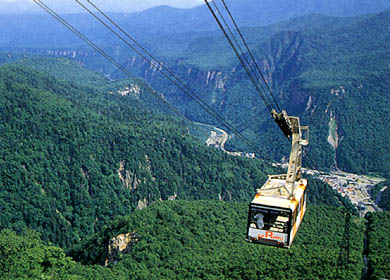 |
| Sounkyo " Kurodake Ropeway " |
 |
| Breathtakingly gorgeous views |
 |
If you want to enjoy the sights of the Mount Taisetsu-san range without having to wear heavy clothes, the Ropeway is for you. If you take both the Gondola and Lift, you can go more than 2/3 up Taisetsu-san to Kuro-Dake Peak (1984 meters high). First take the Ropeway (gondola capacity 101 people) from Sounkyo Sanroku Station halfway up, look down, and you'll see a sea of trees cut only by the Ishikari River, plus continuous canyons. Look up and you'll see Kuro-Dake approach. Then take the Lift up the remaining third of the mountain for fifteen minutes. During July and August you can enjoy an unbroken carpet of mountain verdure, and view the remaining snows of winter on Taisetsu-san during the height of summer. From the beginning of November to the beginning of June there is abundant skiing.
 |
|
| Yuyurin Nature Trail |
Take a leisurely stroll through nature that will make you lose track of time. |
This trail is a barrier-free sloped wooden path that can be easily navigated by wheelchairs. The car park is made of tree bark, so your shoes will not get muddy on wet days.
The trees in the forest have labels telling you what they are called and what they are commonly used for, so you can learn more about the forests as you stroll!
Numerous observation areas have been set up around the lake so you can enjoy the beautiful scenery of Lake Taisetsu.
In the rockfill dam, Japanüfs first multi-purpose dam, you can see the reflection of the virgin forest that surrounds it. No one could imagine that part of this breathtaking scenery is man-made.

|
|
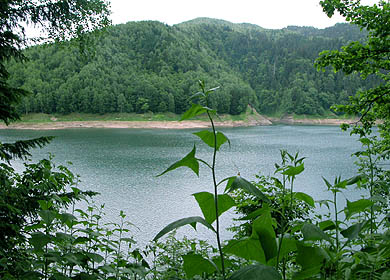 |
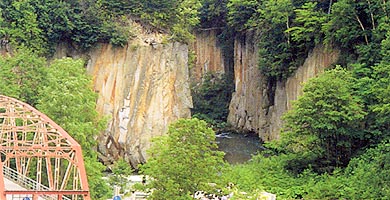 |
| Obako |
Discover the heart of the poet Ujo Noguchi. |
Obako is located 6km from Sounkyo, on the way to Kitami. You can find the entrance to Obako just past the Shin-Obako Tunnel on the left-hand side.
Giant stone columns stretch out before you as if they were arranged there on purpose, just like a folding screen. This is a popular place for taking photos and taking a break from driving.
Obako and Kobako are said to have the most spectacular canyon views in Japan.
* Walking the Kobako Trail is now prohibited, as there is a danger of falling rocks.
|
|
| Sounkyo Visitor Center |
Taisetsuzan National Park Information Center |
As well as offering nature lessons and lectures (the main theme being friendship between people and the nature of the Taisetsuzan National Park), the Center promotes preservation of the natural environment.
In the Center, you can get real-time information on the nature of the area and must-see tourist spots, and experience the four seasons of Taisetsuzan through high-definition video and dioramas.
 |
|
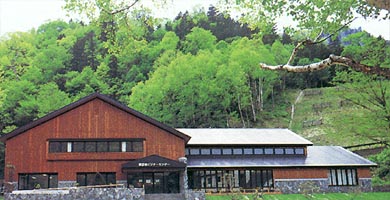 |
|
|
| Asahiyama Zoo |
Japanüfs popular northernmost zoo |
See penguins swimming effortlessly above you in the underwater tunnel in the penguin house, and watch orangutans swinging lazily across their rope trapeze high above your head.
From the ügsealüfs eyeüh, you can experience first hand what it feels like to a seal to be under the nose of a huge polar bear! If youüfre lucky, you may also catch a glimpse of the dynamic, graceful dive of this beautiful beast.
The zoo may only have 150 species of animal, but the unique ügactive displayüh designs of the enclosures lets you watch the delightful animals at close quarters as they go about their natural daily activities.

|
|
| Ice Pavillion |
The beauty of dynamic snow and ice |
A place where you can feel the cold of Hokkaido any time of the year. Even when it's the height of summer and 30 degrees out, you can come inside and experience a world of minus 41 degrees, surrounded by blocks and pillars of ice. Drop by and see a wonderful world of marvellous and beautiful ice.
 |
|
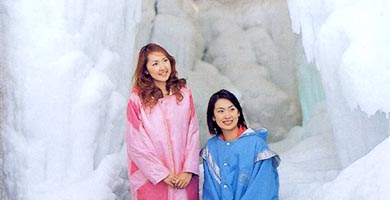 |
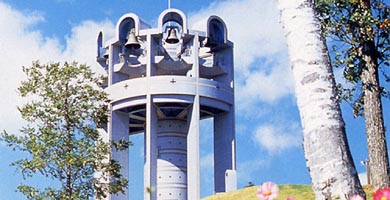 |
| Espoir no Kane |
Ringing in hopes every single day |
"Espoir" means "hope" in French. In 1984, the Town of Kamikawa celebrated its 90th anniversary and built a lookout tower containing this bell, which rings every day every three hours from 9am. The biggest bell in Japan, it symbolizes the hopes of Kamikawa and the wide-ranging beauty of the Mount Taisetsu-san mountain range. |
|
| Kamiyubetsu Tulip Garden |
See 1.2 million tulips from 120 different varieties blooming in unison |
In this 7-hectare field there are about 1.2 million tulips of 120 different varieties. Each year, new varieties are added to the field, some of which are extremely rare varieties imported directly from the Netherlands, and cannot be seen anywhere else in Japan.
The colorful Tulip Fair is held from early May to early June, where over 10,000 people come every year to enjoy the festivities and buy cut flowers and bulbs.
The height of tulip season is around May 25. The progress of the tulips is also posted online so you can time your visit to perfection.
 |
|
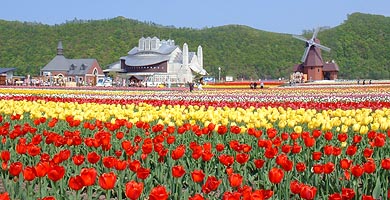 |
 |
| Agriculture Park |
Where cattle graze serenely, protected by the mountains |
Our livestock are raised peacefully in pastures protected by the Taisetsu-san Mountains.
Our high-quality beef is the local delicacy and the pride of Kamikawa. And the world we live in--where cattle roam freely before a blissful panorama--is a pastoral scene in oils come to life. |
|
| Ukishima Shitsugen Wetlands |
More than 70 marshes at a 860-meter mountain pas |
Ukishima has in its vicinity more than 70 marshes of various sizes, encompassing an area of 650 meters east to west, 450 meters north to south. Ukishima is situated right in the middle, with mountain blooms competing for space during the summer.
A dreamlike world of flowers, trees, and wetlands where you can lose yourself and forget your daily troubles. |
|
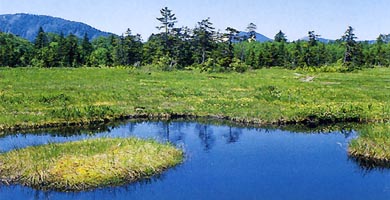 |
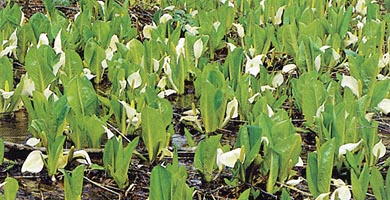 |
| " Mizubasho Koen " Park |
Trumpeting the advent of springtime |
Spring comes to the Taisetsu-san area from June, but nature is long making preparations before. The ancient greens of primeval forest glisten and supervise the young verdure of the nearby canyons. Most noticible are the "mizubasho" (skunk cabbage), which despite the odd name in English are lovely harbingers of approaching warmer weather. Drive your car along Route 39 and witness standing groups of this white leaflike flower commanding your attention with color. Its large bloom trumpets the happiness of spring, and sings the praises of a long-awaited spring and a summer quenched by a year of snowmelt. |
|
| The autumn colors of " Ginsendai " |
A harmonious cornucopia and blend of colors |
After the momentary interlude of summer, the gaudy greens of the mountains give way to the reds, yellows, and fading greens of autumn. Here is where one can view the first fall colors in Japan, threading up the mountains to reach their peak in mid-September. As the needles of conifers sprinkle lightly upon the ground, and the deciduous trees don their reds and yellows and intermingle with even more subtle colors, one wonders how to put into words the spectacle unfolding before one's eyes. Come see it for yourself. From Sounkyo via Lake Taisetsu-sanko, 50 minutes by car along the Mount Taisetsu-san Sightseeing Road |
|
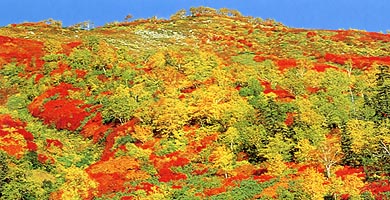 |
|

